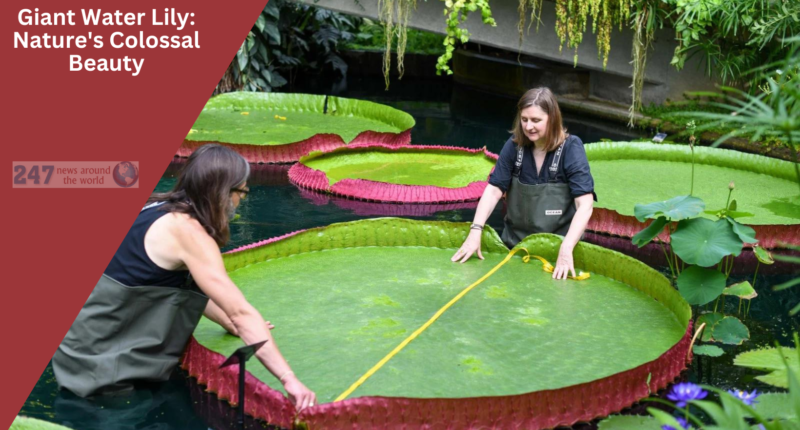A look at “Giant Water Lily: Nature’s Colossal Beauty” Nature never fails to astonish us with its extraordinary creations, and the giant water lily is undoubtedly one of its most awe-inspiring wonders. With its colossal size and captivating beauty, this aquatic plant has fascinated people across the globe.
In this article, we will delve into the enchanting world of the giant water lily, exploring its characteristics, habitat, significance, and more.

See Also | 15 Largest Creatures Found In The Amazon
Unveiling Nature’s Colossal Beauty
Imagine stepping into a serene pond where enormous floating leaves and captivating blossoms dominate the water’s surface. This captivating spectacle is none other than the giant water lily, an extraordinary plant that has captured the hearts of nature enthusiasts worldwide. The giant water lily, scientifically known as Victoria’s Amazonica, is a true marvel of nature.
The Fascinating Characteristics of the Giant Water Lily
The giant water lily showcases a range of intriguing characteristics that make it stand out among its botanical peers. Its leaves, often referred to as “pads,” can reach an astonishing diameter of up to 10 feet (3 meters). These mammoth leaves, held aloft by sturdy ribs and submerged in water, provide support and stability for the plant. The vibrant green pads feature upturned edges that serve the dual purpose of enhancing buoyancy and preventing water from flooding the leaf’s surface.
Habitat and Distribution of the Giant Water Lily
The natural habitat of the giant water lily predominantly lies in the tropical regions of South America, particularly in the Amazon River basin. It thrives in slow-moving or stagnant freshwater environments such as lakes, ponds, and backwaters. The warm climate and ample sunlight of the tropics provide the ideal conditions for the growth and reproduction of this colossal beauty.
The Lifecycle of the Giant Water Lily
The lifecycle of the giant water lily encompasses several stages, each marked by fascinating transformations. It begins with the germination of seeds underwater, followed by the emergence of young plants with floating leaves. As the plant matures, it develops its characteristic enormous pads and produces magnificent flowers. The flowers open at dusk, emitting a delightful fragrance that attracts pollinators, typically beetles and flies. After pollination, the flowers transform into spiky fruits containing numerous seeds, ensuring the continuation of the species.
The Remarkable Adaptations of the Giant Water Lily
To survive and thrive in its watery habitat, the giant water lily has evolved remarkable adaptations. One of the most notable adaptations is its ability to change the shape of its leaves in response to the environment. During periods of heavy rain or rising water levels, the giant water lily adjusts the angle of its leaves, allowing excess water to flow off easily and preventing damage. Additionally, the underside of the leaves is covered with thorny structures, acting as a defense mechanism against herbivores and providing support for the large surface area.
See Also | Green Anaconda Vs Giant Anaconda: Which One is bigger And What’s the Difference?
The Ecological Importance of the Giant Water Lily
The giant water lily plays a vital role in its ecosystem, providing numerous benefits to both flora and fauna. The expansive pads create shade and shelter for aquatic organisms, offering refuge to small fish, amphibians, and invertebrates. The dense roots of the plant provide a safe breeding ground for various aquatic creatures. Moreover, the flowers attract pollinators, contributing to the overall biodiversity of the surrounding environment.
Cultural Significance and Symbolism of the Giant Water Lily
Beyond its biological importance, the giant water lily holds cultural significance and symbolism in various societies. In some indigenous cultures of the Amazon rainforest, the plant is revered for its resilience and beauty, symbolizing purity and spiritual transformation. The iconic image of the giant water lily has inspired artists, writers, and poets, who often use it as a metaphor for grace, serenity, and the delicate balance between strength and fragility.
Threats to the Giant Water Lily and Conservation Efforts
Despite its magnificence, the giant water lily faces several threats to its survival. Habitat destruction due to deforestation, pollution, and urbanization poses a significant risk to its natural habitats. Climate change and invasive species also disrupt the delicate ecosystems where the plant thrives. To combat these challenges, conservation efforts are underway to protect and restore the habitats of the giant water lily. Conservation organizations and local communities are working together to raise awareness, implement sustainable practices, and establish protected areas to ensure the preservation of this remarkable species.
The Giant Water Lily in Art, Literature, and Popular Culture
The mesmerizing beauty of the giant water lily has left an indelible mark on art, literature, and popular culture. From famous paintings depicting serene lily ponds to poetic descriptions in literature, the plant has captivated the imaginations of artists and writers throughout history. In modern times, the giant water lily continues to inspire awe and admiration, appearing in documentaries, botanical gardens, and even as a subject of scientific research and exploration.
Captivating Facts and Records About the Giant Water Lily
- The giant water lily holds the record for having the largest leaves of any aquatic plant.
- It was first discovered by European botanists during expeditions to South America in the 19th century.
- The flowers of the giant water lily change color from white to pink as they age.
- The plant can support the weight of an average-sized adult walking across its sturdy pads.
- The giant water lily has inspired the design of architectural structures, including the Crystal Palace in London.
Growing and Caring for Giant Water Lilies in Your Garden
If you’re a passionate gardener and want to bring a touch of the extraordinary to your backyard, growing giant water lilies can be a rewarding experience. However, it’s important to note that these plants require specific conditions to thrive. They need a large, deep pond or container with still or slow-moving water, ample sunlight, and nutrient-rich soil. Regular maintenance, including trimming and fertilizing, is essential to ensure healthy growth. It’s advisable to consult local experts or specialized nurseries to obtain suitable varieties and proper guidance for successfully cultivating giant water lilies in your garden.
Exploring Giant Water Lily Gardens Around the World
For those fascinated by the grandeur of the giant water lily, visiting renowned water gardens and botanical gardens around the world is a must. These gardens provide an opportunity to witness the majestic beauty of the giant water lily up close and personal. One such renowned destination is the Amazon Rainforest, where the plant is native and can be observed in its natural habitat. Other notable locations include botanical gardens in countries like the United States, the United Kingdom, Brazil, and Thailand. These gardens often have dedicated areas showcasing various species of water lilies, including the magnificent giant water lily, allowing visitors to appreciate their splendor and learn more about their unique characteristics.
Frequently Asked Questions (FAQs)
- Q: How long does a giant water lily live? A: The giant water lily typically lives for 2 to 3 years, but it can vary depending on environmental conditions.
- Q: Are giant water lilies endangered? A: While the giant water lily is not currently classified as endangered, it is facing threats due to habitat destruction and climate change.
- Q: Can giant water lilies grow in colder climates? A: Giant water lilies thrive in tropical climates and require warm temperatures to grow successfully. They are not well-suited for colder regions.
- Q: Do giant water lilies require special care in a garden pond? A: Yes, giant water lilies have specific care requirements, including ample sunlight, nutrient-rich soil, and regular maintenance to prevent overcrowding.
- Q: Are giant water lilies safe for aquatic animals in a pond? A: Yes, the large leaves and roots of the giant water lily provide shelter and breeding grounds for aquatic animals, contributing to a healthy ecosystem.
Conclusion: The Majestic Beauty That Leaves Us in Awe
In the realm of natural wonders, few creations can rival the enchanting allure of the giant water lily. Its colossal size, captivating blossoms, and remarkable adaptations make it a true masterpiece of nature. From its fascinating characteristics and ecological significance to its cultural symbolism and conservation efforts, the giant water lily continues to inspire and captivate people around the world. As we marvel at its beauty and learn more about its intricacies, let us also strive to protect and preserve this majestic plant for future generations to cherish.
See Also | South American Tapir: The Amazon’s Large Herbivore






